Ditching Old Wives’ Tales
Ditching – the word alone can strike fear into pilots and passengers. A recent article in AOPA Pilot magazine claimed that ditching is a very hazardous emergency procedure that most do not survive. AVweb’s Special Projects Editor Doug Ritter, also Editor of the “Equipped to Survive” web site, responds, “hogwash!” In truth, nine out of ten ditchings are successful and a few simple preventive measures can improve on even those excellent odds. Doug exposes numerous old wives’ tales and explains how ditching is an eminently survivable experience.
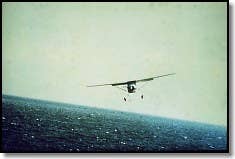
|
The July 1999 issue of AOPA Pilot magazine featured an article by Editor-at-Large Thomas A. Horne titled, "In-Flight Emergencies - Ditching - Putting wings in the water." According to AVweb's Special Projects editor Doug Ritter, who is also publisher and editor of the Equipped to Survive Web site, Horne's article includes much valuable information on ditching and water survival. But, it is also chock full of old wives' tales and incorrect information. The result is not only grossly misleading, but could, and apparently has, dissuaded some pilots from properly preparing for a possible ditching. In the following commentary adapted from the original and in a supporting article from Aviation Safety magazine by respected aviation editor Paul Bertorelli, "Ditching Myths Torpedoed!," Ritter hopes to set straight the record on the survivability of ditching and on the equipment and attitude that can further improve the already high success rate. |
Old Wives' Tales
"Unfortunately, most ditchings are unsuccessful. Even with help close at hand, airplanes often skip once, then flip over or plow under before anyone aboard has a chance to escape."
"If luck is with you, the airplane stays upright and no one is injured to the point of incapacitation. If it isnt, the airplane is hit by a wave and sinks immediately."
 Really? If by "unsuccessful," one means that the airplane can't beused again, that's probably true. On the other hand, I cannot conceive howanyone could interpret the readily available facts to conclude that the majorityof ditchings are unsuccessful, or in other words, that they result in a fatalityor fatalities either in total or due to the failure of the occupants to exit theaircraft. Even a cursory review of NationalTransportation Safety Board (NTSB) or U.S.Coast Guard (USCG) records will reveal that most ditchings are by thismeasure, or any measure, successful, meaning that the occupants escape from theaircraft reasonably intact or that there are no fatalities.
Really? If by "unsuccessful," one means that the airplane can't beused again, that's probably true. On the other hand, I cannot conceive howanyone could interpret the readily available facts to conclude that the majorityof ditchings are unsuccessful, or in other words, that they result in a fatalityor fatalities either in total or due to the failure of the occupants to exit theaircraft. Even a cursory review of NationalTransportation Safety Board (NTSB) or U.S.Coast Guard (USCG) records will reveal that most ditchings are by thismeasure, or any measure, successful, meaning that the occupants escape from theaircraft reasonably intact or that there are no fatalities.
More specifically, Aviation Safety's Paul Bertorelli (a former AVwebNews Editor and currently Editor of The Aviation Consumer) has conducteda review of NTSB accident records in his article "DitchingMyths Torpedoed!". His bottom line on general aviation ditchings:"Although survival rates vary by time of year and water-body type, theoverall general aviation ditching survival rate is 88 percent."Moreover, Bertorelli's analysis concludes that, "... the successfulegress rate is 92 percent, meaning that in more than nine out of 10 cases,at least some of the occupants got out of the airplane and ultimately survivedthe experience." Bertorelli further reports that, "If you excludewhat we consider to be the high-risk over water operations—the long distanceocean ferry flights that are only a small part of the total over waterflying—the egress rate rises to an astonishing 95 percent."
But, what if you only consider open ocean or cold water ditchings where thewaves are bigger, hypothermia becomes a bigger problem, and rescue can be faraway? Is it hopeless? We know of a number of highly publicized instances wherepilots ditching in the North Atlantic survived, which immediately disputes thestatements quoted at the top of this article. Moreover, Bertorelli found,"22 blue water ditchings ... there were four fatalities in this group of22, for a survival rate of 82 percent, not too much worse than it is for coastalor inshore ditchings." So, even the worst possible circumstances don't makethat big a difference in the survival rate.
Bertorelli's numbers are in close agreement with my own research of NTSB andUSCG ditching reports. No mater how you play with the numbers or what fudgefactor you might add to cover unreported ditchings, you are unlikely toadversely impact the results to any significant degree, and certainly not to thedegree necessary to support the statements above, given the known facts.
Why Prepare To Ditch?
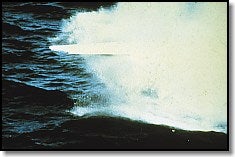 Does the prevalence of such old wives' tales about ditching really mattermuch? Is it really a problem if pilots have a negatively unrealistic expectationabout their survival chances? While at EAA AirVenture Oshkosh 1999, I presenteda Ditching and Water Survival seminar and I spoke with Gerard Pickhardt, V.P. ofWinslow LifeRaft Co. He told me of his experience at the Winslow booth duringthe event discussing with a pilot his interest in a life raft. The pilot wasclearly interested in improving the safety of his operations; however, hestated, "I know if I do ditch though, I don't have a chance ofsurviving." Ergo, why invest in survival gear when the outcome of theditching is unlikely to be successful? In fact, Pickhardt and his aviation salesrepresentative, Steve Weatherly, both reported numerous conversations similar tothis one. I had a few similar ones myself during the course of my stay inOshkosh and via a variety of online media over the past couple months. Pickhardtcommented that while denial by pilots is always something that must be overcometo sell life rafts, as all of us in the flight safety and survival business knowtoo well (see Barry Schiff's "SafetyIs A Tough Sell"), this flurry of abject resignation over the outcomeof a ditching is new — just evident since July . The bottom line is that theseold wives' tales are dangerous and must not actively dissuade pilots frompreparing to survive a ditching.
Does the prevalence of such old wives' tales about ditching really mattermuch? Is it really a problem if pilots have a negatively unrealistic expectationabout their survival chances? While at EAA AirVenture Oshkosh 1999, I presenteda Ditching and Water Survival seminar and I spoke with Gerard Pickhardt, V.P. ofWinslow LifeRaft Co. He told me of his experience at the Winslow booth duringthe event discussing with a pilot his interest in a life raft. The pilot wasclearly interested in improving the safety of his operations; however, hestated, "I know if I do ditch though, I don't have a chance ofsurviving." Ergo, why invest in survival gear when the outcome of theditching is unlikely to be successful? In fact, Pickhardt and his aviation salesrepresentative, Steve Weatherly, both reported numerous conversations similar tothis one. I had a few similar ones myself during the course of my stay inOshkosh and via a variety of online media over the past couple months. Pickhardtcommented that while denial by pilots is always something that must be overcometo sell life rafts, as all of us in the flight safety and survival business knowtoo well (see Barry Schiff's "SafetyIs A Tough Sell"), this flurry of abject resignation over the outcomeof a ditching is new — just evident since July . The bottom line is that theseold wives' tales are dangerous and must not actively dissuade pilots frompreparing to survive a ditching.
More than just convincing them they don't need survival equipment, suchmisinformation also puts pilots in the worst possible state of mind. A positivestate of mind is an individual's most important survival tool. If a pilot isalready convinced his chances of surviving are slim, then there is a good chancethat reality will conform to his preconceptions. The message that a ditchingcannot be survived isn't just wrong and misleading, it is potentially deadly.
High-wing Flips?
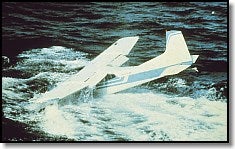 So, what about the oft-repeated old wives' tale that high-wing aircraftalmost always flip over in a ditching and as a result surviving is unlikely insuch circumstances? Records concerning whether high-wing aircraft are morelikely to flip after impact with the water are not so easy to find; NTSB andUSCG records are remarkably silent on this issue. Bertorellifound only one, though that in itself might be significant. However, one candraw some conclusions from the experiences of the large number of ditchingsurvivors who have been interviewed or about whom news articles have beenwritten. I have personally interviewed many such survivors (or their rescuers)in the past five years, approximately half of whom were flying fixed-gear,high-wing aircraft. Only three reported flipping over and completing the waterlanding upside down, and all survived the experience.
So, what about the oft-repeated old wives' tale that high-wing aircraftalmost always flip over in a ditching and as a result surviving is unlikely insuch circumstances? Records concerning whether high-wing aircraft are morelikely to flip after impact with the water are not so easy to find; NTSB andUSCG records are remarkably silent on this issue. Bertorellifound only one, though that in itself might be significant. However, one candraw some conclusions from the experiences of the large number of ditchingsurvivors who have been interviewed or about whom news articles have beenwritten. I have personally interviewed many such survivors (or their rescuers)in the past five years, approximately half of whom were flying fixed-gear,high-wing aircraft. Only three reported flipping over and completing the waterlanding upside down, and all survived the experience.
Irrespective of whether the aircraft ends up sunny-side up or sunny-sidedown, the statistics tell us pilots and passengers generally get out safely.Commenting on the high overall survival rate, Bertorellinotes pointedly, "if every high wing airplane flipped over onimpact or cartwheeled end-over-end across the water — highly unlikely, by theway — the occupants still managed to egress successfully." Is it a bitdisorienting if the ditched aircraft does end up on its back? No doubt it canbe, but that doesnt appear to have any significant impact in the real worldof general aviation ditchings. Is training helpful? Sure, it could keep you outof that small percentage of fatal ditchings, but is unlikely to make a big dentin the overall stats.
Instead, the most common scenario I find is that the aircraft, high orlow-wing, fixed gear or retractable, simply noses into the water sometime afterinitial impact and then bobs back to the surface. All survivors I have spokenwith had adequate time to exit the aircraft before the wings sank below thesurface. However, there is no doubt from my interviews that those flyinglow-wing aircraft have it easier getting out and often report time to getorganized and retrieve items while standing on the wing and before entering thewater or life raft.
There appears to be no data to determine how quickly a particular aircraftwill sink. The vast majority report the aircraft sinking shortly after exiting,but some noted the aircraft floating for a considerable time, up to an hour ormore in a few cases, days in a few others. In one case I find ratherinteresting, the quick-thinking survivor clambered onto the rear fuselage of hisMooney and by holding onto the vertical stabilizer, he balanced the aircraft toprevent it nosing over and sinking for long enough to allow for rescue somehours later.
Practice Makes Perfect
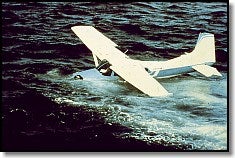 Don't let anyone tell you that you can't practice ditching. Well, no, youcan't actually hit the water, but a major part of practicing forced landings isnot the landing itself, which like a ditching isn't all that different than anormal short and soft field landing, but rather the selection of an appropriatelanding spot. While difficult for land-locked pilots, for anyone who plans tofly regularly over water, or who is interested enough to make the effort, it iseasily done. A pilot can be instructed, or can practice themselves, how toidentify wave and swell patterns, swell and wind direction, and how to preparethe aircraft and any emergency equipment while making a descent towards thewater. Doing so will also allow you to accomplish this from higher altitudes andfar more accurately and quickly.
Don't let anyone tell you that you can't practice ditching. Well, no, youcan't actually hit the water, but a major part of practicing forced landings isnot the landing itself, which like a ditching isn't all that different than anormal short and soft field landing, but rather the selection of an appropriatelanding spot. While difficult for land-locked pilots, for anyone who plans tofly regularly over water, or who is interested enough to make the effort, it iseasily done. A pilot can be instructed, or can practice themselves, how toidentify wave and swell patterns, swell and wind direction, and how to preparethe aircraft and any emergency equipment while making a descent towards thewater. Doing so will also allow you to accomplish this from higher altitudes andfar more accurately and quickly.
This is not significantly different than similar techniques used whenpracticing normal emergency landings. An added benefit is that after the firstattempt to don a life vest under simulated emergency conditions from lowaltitude, the pilot should quickly become convinced of the need to wear a lifevest at all times when flying over water. Preparations for ditchings can andshould be practiced.
What About Night? IMC?
There is also no evidence that night or IMC ditchings are generallyunsurvivable or even unsurvivable in a significant minority of cases, as manyseem to believe. Many pilots and passengers have survived night ditchings. Whilethere is no question that such a procedure is more difficult and riskier — anda whole lot more scary — it is also likely far more survivable than anoff-airport landing under such conditions on land in many areas.
In many circumstances, such as with significant moonlight or light scatterfrom a city nearby, there is ample light to perform a safe ditching undercontrol at night. As for flying over water in IMC, in most cases IMC conditionswill not extend all the way down to the water's surface, so there is time to getset up for the ditching. Judgment based on actual circumstances is necessarybefore deciding whether night or IMC flight over water is inappropriate.Understanding the actual risks is necessary to make such a decision.
To maximize the chances for success, some practical advice is in order. Thisincludes stressing the importance of setting up a gentle descent, and if at allpossible, a slight nose up attitude until contact is made with the water,since if there is zero visibility the pilot won't know when to flare normally.This is obviously easier with power, but by using the altimeter with a recentbarometric setting or a radar altimeter, if so equipped, the pilot can alsoenter the flare at a judicious altitude and hold that attitude until impact,which would likely be far better than impacting in a nose-down attitude.
Just A Passenger?
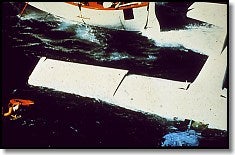 Yet another OWT suggests that once you hit the water the pilot becomes justanother passenger along for the ride — that from that point on the outcome isbeyond his control. That is nonsense. It is critical that the pilot continuesflying the aircraft until it stops, just as in a normal off-airport landing. Mymany interviews with ditching survivors support this concept. This is importantbecause it is quite possible that rather than nose-in, the aircraft may skip offthe surface of the water on initial and subsequent impacts. In such instancesthe pilot must continue to fly and maintain control until the aircraft impactsthe water the final time.
Yet another OWT suggests that once you hit the water the pilot becomes justanother passenger along for the ride — that from that point on the outcome isbeyond his control. That is nonsense. It is critical that the pilot continuesflying the aircraft until it stops, just as in a normal off-airport landing. Mymany interviews with ditching survivors support this concept. This is importantbecause it is quite possible that rather than nose-in, the aircraft may skip offthe surface of the water on initial and subsequent impacts. In such instancesthe pilot must continue to fly and maintain control until the aircraft impactsthe water the final time.
While the aircraft generally decelerates and stops in a very short distance,the pilot may still be able to control the roll attitude of the aircraft to acertain extent for a short time after initial impact, especially in high-wingaircraft, and keeping a wingtip from digging into the water until the lastpossible moment can be a real benefit. The point being that a pilot may wellhave more control than the old wives' tales suggest and it does no good tosuggest otherwise, contributing to a pilot's poor attitude towards survival. Thepoint being that a pilot may well have control of the airplane most of the waythrough the ditching event. "Flying" the airplane through the ditchingas long as possible can only help increase the emergency maneuver'ssurvivability and help overcome the pilot's poor attitude towards survival.
Equipment
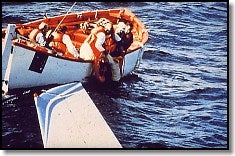 Just as a pilot prepared for an IFR cross-country will have a flight plan,charts, approach plates, etc., handy in the cockpit, ensuring that the rightequipment is available will enhance the survivability of a ditching.
Just as a pilot prepared for an IFR cross-country will have a flight plan,charts, approach plates, etc., handy in the cockpit, ensuring that the rightequipment is available will enhance the survivability of a ditching.
Life Vests
Yes, you do need a vest for every person in the aircraft, and a spare neverhurt. However, forget about donning a life vest on your way down to the water,especially so if you're the pilot. Getting into a vest inside the tight confinesof a typical GA aircraft is difficult at best, even for passengers. As pilot,you have lots more important things to attend to. As noted above, a littlepractice should easily convince you of that. If you're flying over water, wearyour life vest at all times. Quick donning pouch style life vests (often called"helicopter vests") are relatively inexpensive and easy to use. Wornat the waist with the pouch sitting in your lap, the vest is simply pulled overthe head in an emergency. They are perfect for passengers. Pilots may want toconsider a constant-wear vest such as used by the military, USCG, and otherexperienced overwater pilots, as discussed in-depth in Equipped To Survive's AviationLife Vest Reviews article.
Note that conventional aviation life vests are not designed to withstandthe abuse of wearing them during flight and have been known to develop leaksvery quickly. Typical buoyant marine PFDs or auto-inflating PFDs are dangerousand should never be relied upon as they could trap you in an aircraft (USCGapproved inflatable PFDs are okay).
Exposure Suits
 Hypothermia is always a potential danger, even in moderate watertemperatures, but especially in colder waters. The past few years have witnesseda revolution in exposure suit design. For example, there are now numerouscomfortable and practical options for pilots that improve upon the old-styleneoprene closed-cell foam rubber exposure suits similarin many ways to a SCUBA diver's dry suit, but looser and bulkier). Aserious disadvantage of the old-fashioned, ill-fitting neoprene exposure suitsis that they are difficult to fly in if fully donned.
Hypothermia is always a potential danger, even in moderate watertemperatures, but especially in colder waters. The past few years have witnesseda revolution in exposure suit design. For example, there are now numerouscomfortable and practical options for pilots that improve upon the old-styleneoprene closed-cell foam rubber exposure suits similarin many ways to a SCUBA diver's dry suit, but looser and bulkier). Aserious disadvantage of the old-fashioned, ill-fitting neoprene exposure suitsis that they are difficult to fly in if fully donned.
The usual solution to the problem is to fly with the top half rolled down tothe waist. The plan being to complete the donning prior to the ditching in theevent of an emergency. Even then, the feet are clunky and make flying awkward. Unfortunately,sometimes that plan doesn't quite work out. On December 19, 1998, off the coastof Nova Scotia the pilot survived the ditching, but because he was unable tocomplete donning the old-fashioned style immersion suit, he succumbed tohypothermia after exiting the aircraft. It was determined that he wouldotherwise have survived.
The new-style exposure suits fit much better and are much more comfortable.One increasingly popular concept adopted by the military and now available tothe rest of us from companies such as Multifabsand Mustangis a design that looks not much different from a conventional military styleflight suit, but which incorporates a GORE-TEX waterproof membrane andwaterproof zipper, and in some designs, highly effective insulation or insulatedunderwear. A hood is rolled under the collar until needed, thermal glovesattached by tethers are in quick-access pockets on the sleeves. IntegratedGORE-TEX socks/booties allow use of normal footwear, making flying much easier.These suits are actually quite comfortable for extended wear, which means theyare more likely to be worn when needed, instead of only when required byregulations.
These type suits are used daily in the North Sea oil fields and elsewhere andare well proven in actual survival episodes. Because the materials aren'tinherently buoyant like the closed-cell neoprene foam is (an inflatable lifevest is still required) they can't possibly trap someone inside a sinkingaircraft. They are also far easier to maneuver in, an advantage inside as wellas once egress is completed. In addition, the fabric is less likely to snag orto be torn, both potentially life-threatening problems.
Waterproofing
 Often, pilots attempt to waterproof various pieces of survival equipment likea handheld communications radio using the tools which are readily at hand,including plastic Ziploc bags. A simple plastic bag may be better than nothing,but is certainly not the best idea when lives are at stake. They are too easilypunctured or inadvertently unsealed, and many are not truly waterproof. Instead,waterproof pouches specifically designed for the purpose are available frommanufacturers, from most marine supply stores and from Web sites such as WestMarine at relatively low cost. If you plan on depending upon your handheldfor emergency use, it only makes sense to make sure it will be useable.
Often, pilots attempt to waterproof various pieces of survival equipment likea handheld communications radio using the tools which are readily at hand,including plastic Ziploc bags. A simple plastic bag may be better than nothing,but is certainly not the best idea when lives are at stake. They are too easilypunctured or inadvertently unsealed, and many are not truly waterproof. Instead,waterproof pouches specifically designed for the purpose are available frommanufacturers, from most marine supply stores and from Web sites such as WestMarine at relatively low cost. If you plan on depending upon your handheldfor emergency use, it only makes sense to make sure it will be useable.
While combined VHF and GPS handhelds are available, it likely would be farmore economical and result in better com performance to rely upon separatehandheld devices for radio and GPS, particularly since most pilots already ownboth and many GPSs are already waterproof (check your units specifications).If not, waterproof pouches for GPS units are available as well, or, smallwaterproof GPS navigators are available for under $125.
In addition, don't forget your cell phone; in many instances it will workbetter than a VHF radio. You can get waterproof pouches for them as well.
Crash Axes?
We all know about the irony that exists for airline pilots passing throughairport security; the pilot goes on to the cockpit where there's a potentiallydeadly crash axe stored for emergency use. Would such a crash axe be of use fora pilot of the typical light general aviation aircraft who was trapped after aditching? As a member of the SAEAerospace Council, Aircraft Division, S-9 Cabin Safety Provisions and S-9ASubcommittee - Evacuation and Ditching Systems, which just happens to becurrently developing standards for Aviation Crash Axes, I am particularlyfamiliar with this subject at this time. The effectiveness of a crash axe inmost situations is highly variable. One aspect of its use that isincontrovertible, however, is that to be at all effective requires thatconsiderable force be delivered by swinging the axe through an arc of some sort,which is highly unlikely within the compact confines of most light GA aircraftcabins or cockpits, especially if the pilot is not alone, and impossible ifsubmerged.
A far more effective means of opening most GA aircraft doors and fixedwindows, and a method widely accepted in the safety and survival industry, is touse both feet to push outward while bracing oneself against some portion of theinterior. Numerous survivors have escaped this way and this has beendemonstrated to work on just about any opening or window except in pressurizedaircraft, in which case the crash axe is unlikely to be of much use, anyway.
Life Rafts
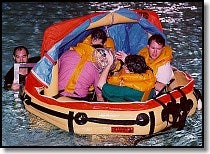 Any life raft is better than no life raft. However, as with most things inaviation, life rafts come in all manner of quality and description. And, as withmost things in aviation, or life for that matter, if you don't pay for it, yourarely get it. While it is possible to purchase a new life raft for$1,000, it will be the least capable available life, as Equipped ToSurvive's in-depth AviationLife Raft Reviews article explains. Such an inexpensive raft will have asingle buoyancy chamber with no survival equipment, boarding aids, ballast, orcanopy. In essence, it is little more than a self-inflating inner tube with afloor.
Any life raft is better than no life raft. However, as with most things inaviation, life rafts come in all manner of quality and description. And, as withmost things in aviation, or life for that matter, if you don't pay for it, yourarely get it. While it is possible to purchase a new life raft for$1,000, it will be the least capable available life, as Equipped ToSurvive's in-depth AviationLife Raft Reviews article explains. Such an inexpensive raft will have asingle buoyancy chamber with no survival equipment, boarding aids, ballast, orcanopy. In essence, it is little more than a self-inflating inner tube with afloor.
A "good raft," having the most critical features survivalauthorities recommend, such as dual buoyancy chambers for redundancy, effectiveboarding aids to assist getting into the raft from the water (otherwiseextremely difficult), enough ballast to prevent capsizing, a canopy forprotection, and a basic survival kit, will set you back closer to $2,500,minimum. At the least you'd want to consider dual buoyancy chambers and decentboarding aids and, if possible, ballast. That will cost in the neighborhood of$1800 - $2,000, minimum. The bottom line is you can't expect to buy a verycapable life raft for $1,000, so don't fool yourself into thinking that you can.
Signaling Devices
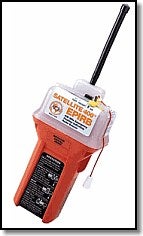 Finally, with regards to signaling equipment, it should be noted that the singlemost highly-effective survival signaling device is a 406 MHz emergency beacon.The advantagesoffered by the 406 MHz beacon are key to a quick rescue. As the worldlearned during the search for JFK Jr.'s Piper Saratoga, the ELT in the aircraftisn't going to be much help once the aircraft submerges.
Finally, with regards to signaling equipment, it should be noted that the singlemost highly-effective survival signaling device is a 406 MHz emergency beacon.The advantagesoffered by the 406 MHz beacon are key to a quick rescue. As the worldlearned during the search for JFK Jr.'s Piper Saratoga, the ELT in the aircraftisn't going to be much help once the aircraft submerges.
There are a number of affordable 406 EPIRBs (the marine equivalent ofaviation's ELT) available which will ensure immediate notification ofauthorities and near instantaneous accurate location of the survivors (unlike121.5 beacons). These 406 EPIRBs are also available for rent, for those pilotswhose need is infrequent. Anyone flying over water should seriously consideradding a 406 EPIRB to his survival equipment. Pocket-sizepersonal 406 MHz beacons are on the way, but there is no reason to wait.
Failing that, pilots should at least consider a pocket-size personal 121.5MHz EPIRB. The new SeaMarshall lists for only about $129 and could save your life. Not a substitutefor a 406 beacon, but much better than nothing and easy to carry at all times,no matter where you are flying.
Another notable improvement in signaling equipment is the SEE/RESCUEstreamer, a modern replacement for the short-lived, problematic, andoutmoded sea marker dye. This is a far more effective signaling product, onereason it has been accepted by the military as a replacement for marker dye andalso why the USCG is taking steps to include the SEE/RESCUE in all theirsurvival vests.
Conclusion
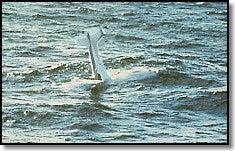 Certainly, being forced to ditch an aircraft in open water is a stressful,traumatic experience. Believing in old wives' tales and being unnecessarilyfatalistic about one's chances or being ill-prepared to use the most effectivetechniques and technologies available to maximize one's success can onlycompound that stress and trauma. The end result could well be to cause anotherwise survivable ditching to end up among the increasingly few that were notsuccessful.
Certainly, being forced to ditch an aircraft in open water is a stressful,traumatic experience. Believing in old wives' tales and being unnecessarilyfatalistic about one's chances or being ill-prepared to use the most effectivetechniques and technologies available to maximize one's success can onlycompound that stress and trauma. The end result could well be to cause anotherwise survivable ditching to end up among the increasingly few that were notsuccessful.
Instead, understanding the risks, planning for the event, ensuring that theproper equipment is available and that the crew is well-trained in its use willnot only inspire confidence but will also greatly enhance the already excellentchances for success. As with so many other facets of aviation, preparationand understanding are the keys and improve the safety, utility, efficiency andenjoyment of your flying.
For additional information related to this subject on Equipped To Survive:
Ditching Myths Torpedoed!
Paul Bertorelli blows many ditching myths out of the water in an in-depth review of NTSB ditching statistics.Surviving a Splashdown
Doug Ritter explains how to improve your odds in a ditching — detailed techniques and tips.Water Wings
Barry Schiff reviews ditching procedures and techniques - from "Proficient Pilot - Volume 2."Additional Ditching information on Equipped To Survive
Everything you always wanted to know about ditching — and then some. Includes true life survival stories.






